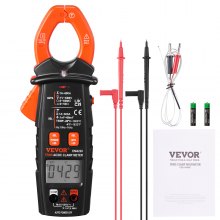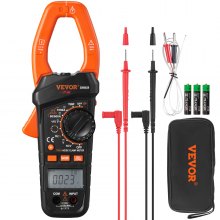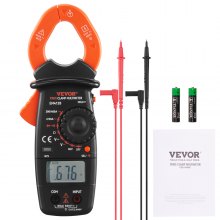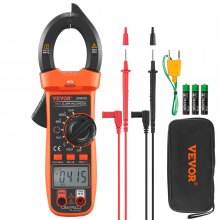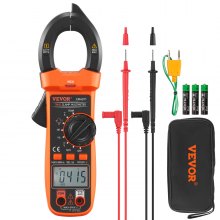Maximize Electrical Efficiency with VEVOR Amp Clamps: Invest Wisely
Electrical test tools called clamp meters measure current without connecting to a circuit in series. They are simple to operate and can measure live wires without harming or cutting off power.
These are tools for convenient and safe current measurement. VEVOR amp clamps are a vital addition to any tool because they provide a special combination of accuracy, robustness, and cost.
Clamp meters are devices that measure current effectively, safely, and without the need for test leads. A magnetic field may emerge from a conductor carrying current.
Thus, the corresponding current can be read by employing this gadget to detect the magnetic field. The experts can measure very safely and swiftly because these gadgets do not interfere with the current flow.
Current is measured via clamps. Probes measure voltage. When an electrical meter has a hinged jaw, technicians can safely clamp across a wire, cord, or conductor anywhere in an electrical system to measure current in the circuit without disconnecting or de-energizing.
Hidden beneath their plastic moldings, the ferrite iron hard jaws are designed to sense, focus, and quantify the magnetic field produced by current flowing through a conductor.
This multipurpose instrument makes it easier to accurately measure electric current, even without a direct connection or circuit interruption, thanks to its clamping mechanism.
It is an essential tool for electrical upkeep and repair since it effectively measures current and can also measure resistance, voltage, and occasionally even frequency.
How to Choose a Clamp Meter
To select the best clamp meter for you, you must understand a few important aspects of the tool and your particular demands. This detailed tutorial will help you choose the best clamp meter.
Current to be Measured
The kind of current being measured determines the kind of clamp meter that needs to be used. While certain clamp meters are made to measure load current, others are made to measure leakage current, which is required in circumstances like short circuits.
Rectification Method
When utilizing an instrument of the load current type, you must be aware of variations in the rectification technique. True RMS rectification and mean value rectification are the two techniques. Be cautious because distorted current waveforms' RMS values cannot be reliably measured using mean value rectification.
AC or DC Current
Whether you're measuring AC or DC will also determine the kind of clamp meter you need to utilize. Make sure to check the clamp meter's frequency band because measuring AC can include changing frequencies.
Instrument Compatibility
A clamp meter determines the maximum cable thickness at which the tool can be clamped. You must specify the width of the wire you want to measure.
Tips for Using the Clamp Meter
Understanding a clamp meter's characteristics and functions, as well as recommended practices that guarantee electrical measuring accuracy and safety, is necessary for efficient use. Here are a few vital tips regarding clamp meter use.
• Before using the clamp meter, carefully read the instructions to determine whether it is AC or AC/DC dual-purpose gear.
• The system's voltage must be tested to stay below the figure displayed on the clamp meter, which could result in an electrical shock hazard or grounding mishap.
• Only one phase conductor's current can be monitored at a time. Multi-phase wires cannot be clamped into the clamp-shaped window for measurement; instead, the test wire must be positioned in the middle of the window.
• You should calculate the measured current before using the clamp meter and choose which range to utilize. If estimation is not feasible, start with the greatest range and adjust it to a lower one later with a more precise reading. To avoid damaging this clamp meter, avoid measuring high currents using the low current gear.
• When measuring, the jaws should be firmly closed. After shutting, if there's a sound, open the jaws, then close them again. If the noise is still not gone, you should make sure the magnetic circuit's joint surfaces are clean and smooth. If there is any dust, wipe it off.
• The following techniques can be applied for measuring low currents because the clamp meter's accuracy is low: After winding the test circuit's wire a few times, place it in the clamp meter's jaws to take a measurement. The clamp meter's current reading does not match the value that is being measured at this moment. The clamp meter's reading divided by the wire's number of twists should yield the actual current.
• To prevent shock, please refrain from using electricity during maintenance.
Why Purchase VEVOR Amp Clamp Meters?
VEVOR amp clamp meters are distinguished in the competitive electrical testing equipment market by their unique combination of precision, dependability, and affordability.
These clamps include a big jaw opening to handle thick cables, true RMS for accurate measurements on non-linear loads, and durable construction for complex settings.
VEVOR combines cost and sophistication by providing cutting-edge features, including a backlit display for low-light usability and non-contact voltage sensing.
FAQs About Amp Clamp Meters
Is a clamp meter better than a multimeter?
A clamp meter is specifically made for measuring current, although a multimeter typically measures resistance, voltage, continuity, and occasionally low current.
One key difference between a clamp meter and a multimeter is its ability to measure high currents. In terms of accuracy, the multimeter exhibits greater precision and dependability. Each is superior in its own right.
Can a clamp meter measure Watts?
On active circuits, the clamp meter is used to measure alternating current. Amperes are used to measure the current. Since Watts are a unit of power rather than watts, the clamp meter cannot measure in Watts; however, wattage is easily calculated according to Ohm's law.
How accurate is a clamp meter?
These meters normally have rather good accuracy. However, anything below ten amps must be more accurate concerning DC clamp meters.
By adding 5–10 twists of wire, a clamp meter's accuracy can be significantly increased. After obtaining the low current, pass it via this wire. There will be accuracy in the reading.




























